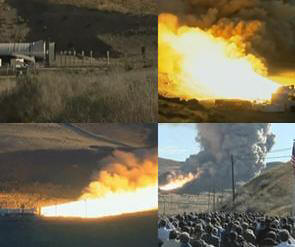|
|||||||||||
|
|
|
|||
|
By Jim Douglas |
||||
 |
September 01, 2010
- On Tuesday, with a loud roar and mighty column of flame, NASA
and ATK Aerospace Systems successfully completed a two-minute,
full-scale test of the largest and most powerful solid rocket motor
designed for flight. The motor is potentially transferable to future
heavy-lift launch vehicle designs.
The stationary
firing of the first-stage development solid rocket motor, dubbed DM-2,
was the most heavily instrumented solid rocket motor test in NASA
history. More than 760 instruments measured 53 test objectives. Prior to the static test, the solid rocket motor was cooled to 40 degrees Fahrenheit to verify the performance of new materials and assess motor performance at low temperatures during the full-duration test. Initial test data showed the motor performance met all expectations. |
|||
|
|
||||
|
"For every few
degrees the temperature rises, solid propellant burns slightly faster
and only through robust ground testing can we understand how material
and motor performance is impacted by different operating conditions,"
said Alex Priskos, first stage manager for Ares Projects at NASA's
Marshall Space Flight Center in Huntsville, Ala. "Ground-testing at
temperature extremes pushes this system to its limits, which advances
our understanding of five-segment solid rocket motor performance."
The first-stage
solid rocket motor is designed to generate up to 3.6-million pounds of
thrust at launch. Information collected from this test, together with
data from the first development motor test last year, will be evaluated
to better understand the performance and reliability of the design.
Although similar
to the solid rocket boosters that help power the space shuttle to orbit,
the five-segment development motor includes several upgrades and
technology improvements implemented by NASA and ATK engineers. Motor
upgrades from a shuttle booster include the addition of a fifth segment,
a larger nozzle throat, and upgraded insulation and liner. The motor
cases are flight-proven hardware used on shuttle launches for more than
three decades. The cases used in this ground test have collectively
launched 48 previous missions, including STS-1, the first shuttle
flight. |
||||


